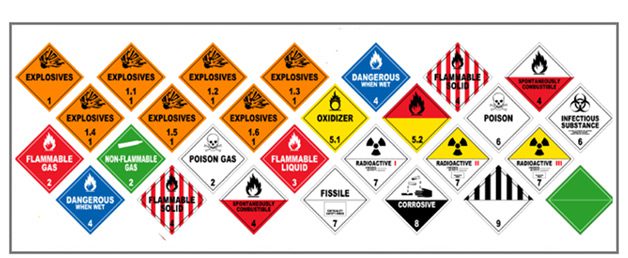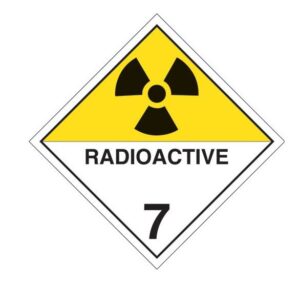
In our last blog, What Defines a Hazardous Material, we began to discuss the different definitions of hazardous waste and materials based on the regulating agency that is defining them. Part of understanding these materials is to determine which class they fall under, this will be your guide to understanding how to adequately handled them.
Classes of Hazardous Materials
Hazardous materials are broken down into 8 main classes, and the 9th miscellaneous class covering all other materials that don’t fall under the first 8.
Class 1 – Explosives
Explosives meet the hazardous materials classification (Class 1) because they have the ability to produce hazardous amounts of heat, sound, smoke, gas or light. They are also capable, through a chemical reaction, of producing gases at speeds, temperatures, and pressures that can cause disastrous damage.
Class 2 – Gases
Gases include compressed, liquefied, dissolved, refrigerated liquefied, aerosols, and other gases. They are defined by the hazardous materials classification (Class 2) as “substances that have a vapor pressure of 300 kPa or greater at 50°c or are completely gaseous at 20°c at standard atmospheric pressure.” Gases are considered dangerous because they pose an imminent threat as a potential asphyxiate and because they are often extremely flammable.
Class 3 – Flammable Liquids and Combustible Liquids
Flammable liquids or combustible liquids are volatile, and can often give off a flammable vapor. They are defined by the hazardous materials classification (Class 3) as “liquids, mixtures of liquids or liquids containing solids in solution or suspension which give off a flammable vapor, and have a flash point at temperatures not more than 60.5°C or 141°F.” Flammable liquids are capable of posing serious threats because of their volatility, potential of causing severe conflagrations and combustibility.
Class 4 – Flammable Solids and Spontaneously Combustible Materials
Flammable solids fit within the hazardous materials classification (Class 4) because they are highly combustible, are capable of posing serious hazards due to their volatility, combustibility, potential in causing or propagating severe conflagrations and can even cause fire through friction.
Flammable solids are defined as “materials under conditions encountered in transport, are combustible or may cause or contribute to fire through friction, self-reactive substances which are liable to undergo a strongly exothermic reaction or solid desensitized explosives.”
Class 5 – Oxidizers and Organic Peroxides
Oxidizers are substances that can produce oxygen. They are within the hazardous materials classification (Class 5) because the right circumstances they can contribute to the combustion of other hazardous substances, though they are not always combustible themselves. Oxidizers can be defined as “substances that can cause or contribute to combustion, typically by producing oxygen as a result of a redox chemical reaction.” Organic peroxides are considered dangerous goods because they are thermally unstable and can exude heat while undergoing exothermic auto-catalytic decomposition. These materials can also undergo explosive decomposition, burn rapidly, be sensitive to friction, or react dangerously with other substances.
Class 6 – Toxic Materials and Infectious Substances
Toxic materials fall under the hazardous materials classification (Class 6) because of the ability to cause serious injury or death if swallowed, inhaled or contact is made with skin. Infectious substances are also classified as a dangerous good for containing pathogens, which includes bacteria, viruses, parasites and/or other agents which can cause disease to humans or animals when contact is made. Dangerous goods regulations define pathogens as “microorganisms, such as bacteria, viruses, rickets, parasites, and fungi, or other agents which can cause disease in humans or animals.”

Class 7 – Radioactive Materials
Radioactive materials are defined by hazardous materials classification as “any material containing radionuclides where both the activity concentration and the total activity exceeds certain pre-defined values.” While undergoing radioactive decay, radioactive materials can emit harmful ionizing radiation.

Class 8 – Corrosive Materials
Corrosive are substances that degrade or disintegrate other materials upon contact through a chemical reaction if leakage, or damage occurs to the surrounding materials. It is capable of destroying materials, such as living tissues. The department of transportation considers an acid with a pH <2 or greater than 12.5 to be corrosive.
Class 9 – Miscellaneous Dangerous Goods
As the name implies, miscellaneous hazardous materials classification (Class 9) are substances that present an imminent threat that is not covered within the definitions of the other 8 classes. Class 9 miscellaneous dangerous goods present a wide variety of potentially hazardous threats to human health and safety, infrastructure and/or their means of transports. They are defined as but not limited to “environmentally hazardous substances, substances that are transported at elevated temperatures, miscellaneous articles and substances, genetically modified organisms and micro-organisms and magnetized materials and aviation regulated substances.”
